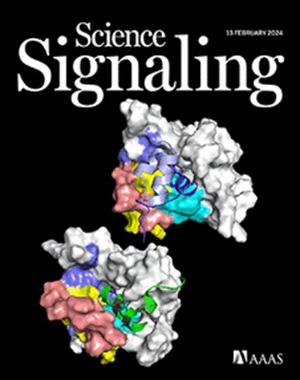Astrocytic RIPK3 exerts protective anti-inflammatory activity in mice with viral encephalitis by transcriptional induction of serpins
IF 6.6
1区 生物学
Q1 BIOCHEMISTRY & MOLECULAR BIOLOGY
Science Signaling
Pub Date : 2025-07-15
引用次数: 0
Abstract
Flaviviruses pose a substantial threat to public health because of their ability to infect the central nervous system (CNS). Receptor-interacting protein kinase 3 (RIPK3) is a central coordinator that promotes neuroinflammation during viral infection of the CNS, a role that occurs independently of its canonical function in inducing necroptosis. Here, we used mouse genetic tools to induce astrocyte-specific deletion, overexpression, and chemogenetic activation of RIPK3 to demonstrate an anti-inflammatory function for astrocytic RIPK3. RIPK3 activation in astrocytes promoted host survival during flavivirus encephalitis by limiting immune cell recruitment to the CNS. Despite inducing a proinflammatory transcriptional program, astrocytic RIPK3 restrained neuroinflammation by increasing the abundance of the protease inhibitor SerpinA3N, which preserved blood-brain barrier integrity, reduced leukocyte infiltration, and improved survival outcomes during flavivirus encephalitis. These findings highlight a previously unappreciated role for astrocytic RIPK3 in suppressing pathologic neuroinflammation.
星形细胞RIPK3通过转录诱导蛇形蛋白在病毒性脑炎小鼠中发挥保护性抗炎活性
黄病毒具有感染中枢神经系统(CNS)的能力,对公众健康构成重大威胁。受体相互作用蛋白激酶3 (Receptor-interacting protein kinase 3, RIPK3)是中枢协调物,在中枢神经系统病毒感染期间促进神经炎症,其作用独立于其诱导坏死性坏死的规范功能。在这里,我们使用小鼠遗传工具诱导星形胶质细胞特异性的RIPK3缺失、过表达和化学发生激活,以证明星形胶质细胞RIPK3的抗炎功能。星形胶质细胞中的RIPK3激活通过限制免疫细胞向中枢神经系统的募集来促进黄病毒脑炎期间宿主的存活。尽管诱导了促炎转录程序,星形细胞RIPK3通过增加蛋白酶抑制剂SerpinA3N的丰度来抑制神经炎症,从而保持了血脑屏障的完整性,减少了白细胞浸润,提高了黄病毒脑炎期间的生存结果。这些发现突出了星形细胞RIPK3在抑制病理性神经炎症中的作用。
本文章由计算机程序翻译,如有差异,请以英文原文为准。
求助全文
约1分钟内获得全文
求助全文
来源期刊

Science Signaling
BIOCHEMISTRY & MOLECULAR BIOLOGY-CELL BIOLOGY
CiteScore
9.50
自引率
0.00%
发文量
148
审稿时长
3-8 weeks
期刊介绍:
"Science Signaling" is a reputable, peer-reviewed journal dedicated to the exploration of cell communication mechanisms, offering a comprehensive view of the intricate processes that govern cellular regulation. This journal, published weekly online by the American Association for the Advancement of Science (AAAS), is a go-to resource for the latest research in cell signaling and its various facets.
The journal's scope encompasses a broad range of topics, including the study of signaling networks, synthetic biology, systems biology, and the application of these findings in drug discovery. It also delves into the computational and modeling aspects of regulatory pathways, providing insights into how cells communicate and respond to their environment.
In addition to publishing full-length articles that report on groundbreaking research, "Science Signaling" also features reviews that synthesize current knowledge in the field, focus articles that highlight specific areas of interest, and editor-written highlights that draw attention to particularly significant studies. This mix of content ensures that the journal serves as a valuable resource for both researchers and professionals looking to stay abreast of the latest advancements in cell communication science.
 求助内容:
求助内容: 应助结果提醒方式:
应助结果提醒方式:


